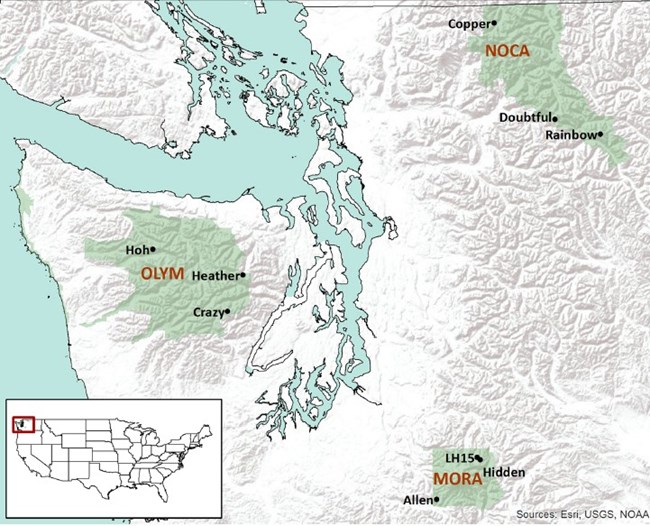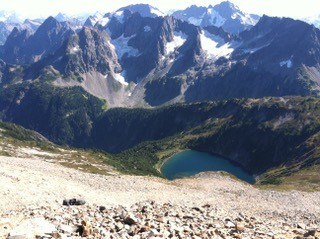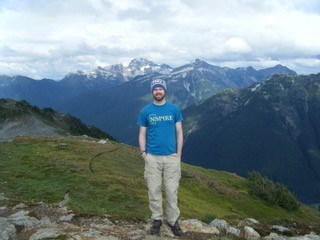Last updated: December 13, 2018
Article
Effects of Nitrogen Deposition on High Alpine Lakes in North Coast and Cascades Parks
Introduction
Remote high alpine lakes are sensitive indicators of atmospheric nitrogen (N) deposition. In the Pacific Northwest, N concentrations in alpine lake water are often naturally very low, which restricts growth of phytoplankton that are the base of the food web. Lakes have distinctive communities of species that have evolved under these conditions. Anthropogenic N deposition originating from the burning of fossil fuels and agricultural practices has increased concentrations of reactive N in lakes, specifically nitrate (NO3-). Reactive, inorganic, N is the only form that can be directly used by organisms. By increasing lake N, anthropogenic N deposition has potential to stimulate phytoplankton growth, and shift phytoplankton growth from N-limited to phosphorus-limited with resulting changes in species composition and ecosystem function.

Research Study
For his doctoral research, Dr. Jason Williams performed experiments in nine high elevation lakes across Mount Rainier (MORA), Olympic (OLYM), and North Cascades (NOCA) National Parks (Figure 1).
At each site, lake water was collected in containers and differing levels of reactive inorganic nitrogen were added to each container. Containers were then submerged in the lake for several days to simulate environmental conditions.
These experiments were designed to simulate lake N enrichment that is expected to occur with increasing Anthropogenic N deposition, and measure corresponding phytoplankton growth responses.
Measuring phytoplankton growth, and identifying the lake N concentrations that stimulates growth can assist lake monitoring programs. It is also a first step towards calculating a critical load, or threshold rate of N deposition below which ecological effects do not occur.
Results
Experimental N additions demonstrated that increasing lake N can stimulate growth of both individual species and overall phytoplankton biomass Additions increased phytoplankton biomass two to three times relative to control treatments. Based on the results, a N concentration of 13 micrograms of N per liter (µg N/L) stimulated an increase overall phytoplankton biomass. Above 25 ug N/L, the increase in phytoplankton biomass was larger than typical inter-annual variation in biomass. As part of his study, Dr. Williams reviewed previously-collected water chemistry data from the parks. He determined 26% of the sampled lakes at MORA and NOCA have dissolved inorganic N concentrations that exceeded the lower (more protective) concentration of 13 µgN/L while no lakes exceeded the limit at OLYM.
Atmospheric N deposition rates are generally lower in the Pacific Northwest (PNW) than in some other mountain regions, like the Rocky Mountains and Sierra Nevada. Lakes in the Pacific Northwest (PNW) generally have lower N concentrations and phytoplankton appear less impacted by N deposition. However, results suggest phytoplankton changes similar to those observed in other regions can also be expected in PNW mountain lakes if anthropogenic N deposition increases further.

Applications in the NPS
Mountain lakes (Figure 2) are often the first to respond to increases in N deposition through changes in phytoplankton species composition and growth. This may lead to alterations in food webs and ecosystem processes. Phytoplankton in mountain lakes are an ecological indicator NPS can use to assess or prevent N deposition impacts and thereby meet mandates for protecting park resources.

Researchers
Jason Williams became interested in lakes in college, when he first looked at lake water under a microscope and learned about the small but amazing organisms that live in lakes. Researching remote mountain lakes was a challenging but rewarding experience. Jason is thankful to NCCN staff for that opportunity and for all their help. He also couldn’t have done the work without four great field assistance (Jordan, Charlie, Camden, and Mikell). Jason earned a B.A. in Biology from Augustana College (Rock Island, IL), a M.S. in Biology from SUNY-Syracuse, and a PhD in Engineering Science from Washington State University. He now works for the Idaho Department of Environmental Quality.
More Information
Regina M. Rochefort, Ph.D.
North Cascades National Park Service Complex
Email: regina_rochefort@nps.gov
Phone: 360-854-7202
Tonnie Cummings, NPS Air Resource Specialist
Pacific West Region
Email: e-mail us
Phone: 360-816-6201
Dr. Jason Williams
Email: jjwill04@gmail.com
Prepared by: Rebecca Evans
Graduate Student, Washington State University
Air Resources Assistant, GeoScientist in the Park
